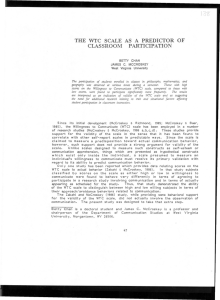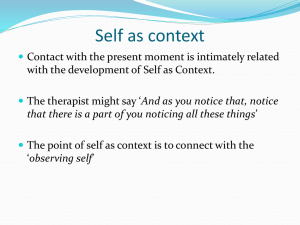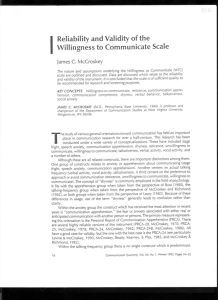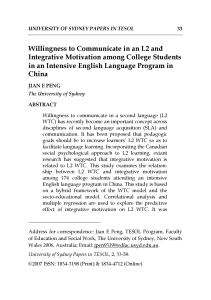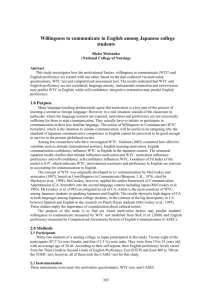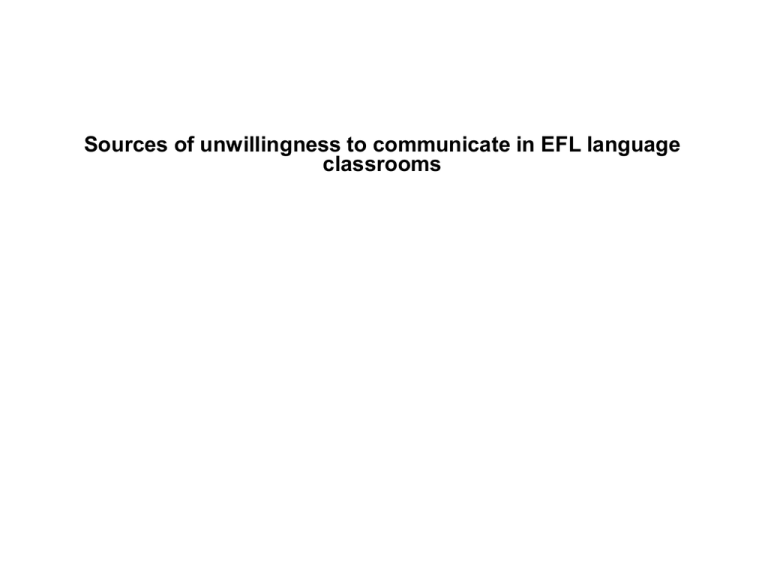
Sources of unwillingness to communicate in EFL language
classrooms
• This study investigated sources of learners’
unwillingness to communicate in EFL language
classrooms. A group of 60 Iranian EFL learners
participated cooperatively and voluntarily in different
phases of the study. By giving them questionnaires, the
most influential factors and sources of unwillingness to
communicate in classrooms were determined.
Proficiency and anxiety were singled out as the most
important reasons for unwillingness to communicate. In
addition, the other factors such as the type of feedback
they received, situational variables and topic familiarity
were also mentioned as influential factors.
• The willingness to communicate (WTC) can be conceptualized as a
readiness to speak in the L2 at a particular moment with a specific
person, and as such, is the final psychological step to the initiation of
L2 communication (MacIntyre, 2007). WTC can be conceptualized to
reflect individual differences in a stable disposition toward
communication, or vary from situation to situation, and even moment to
moment (MacIntyre et al., 1998; Saint Le´ger and Storch, 2009).
Although many of the variables that interact to predict L2
communication (see Do¨rnyei, 2005) change with the time frame being
studied, in this study we are adopting a trait-like approach, similar to
McCroskey’s original work with native language communication
(see McCroskey and Richmond, 1991).
• The willingness to communicate (WTC) can be conceptualized as a
readiness to speak in the L2 at a particular moment with a specific
person, and as such, is the final psychological step to the initiation of
L2 communication (MacIntyre, 2007). WTC can be conceptualized to
reflect individual differences in a stable disposition toward
communication, or vary from situation to situation, and even moment to
moment (MacIntyre et al., 1998; Saint Le´ger and Storch, 2009).
Although many of the variables that interact to predict L2
communication (see Do¨rnyei, 2005) change with the time frame being
studied, in this study we are adopting a trait-like approach, similar to
McCroskey’s original work with native language communication
(see McCroskey and Richmond, 1991).
• The willingness to communicate (WTC) can be conceptualized as a
readiness to speak in the L2 at a particular moment with a specific
person, and as such, is the final psychological step to the initiation of
L2 communication (MacIntyre, 2007). WTC can be conceptualized to
reflect individual differences in a stable disposition toward
communication, or vary from situation to situation, and even moment to
moment (MacIntyre et al., 1998; Saint Le´ger and Storch, 2009).
Although many of the variables that interact to predict L2
communication (see Do¨rnyei, 2005) change with the time frame being
studied, in this study we are adopting a trait-like approach, similar to
McCroskey’s original work with native language communication
(see McCroskey and Richmond, 1991).
• METHODOLOGY
• The participants of this study are Iranian
EFL high school learners of English at
private institutes. 60 students were chosen
as representatives of a larger population of
nearly 500 students. Sex is not taken into
accounts; for this there are both sexes
among the samples.
•
Two questionnaires were distributed among 150 EFL students.
Initially,
open-ended Questions were given to students in order to express their
reasons for unwillingness to communicate in classrooms in a relax
atmosphere. Then, given answers and reasons were categorized from the
most frequent and common one to the least. After that, based on those
responses and reasons a close-ended one was distributed among them. Beside
the reasons set forth by the participants, so many other factors referred to the
topic were also added to the closed-questionnaire.
•
Data analysis
•
To show any normal or abnormal results of the data Kolmogrov smear Nvf was used.
Because the Sig = 0.846 α = 0.05 is greater than the normal, the results of the data analysis
are accepted and we can use parametric tests. The correlation between the dependent
variable (Unwillingness to communicate in Language classrooms) and the independent
variables (factor 6) was calculated and it was equal to 0.982, which indicates a strong relation
between the dependent variable and six independent variables. All six factors had a Sig =
0.000
α
=
0.05
which
is smaller than critical, thus all six factors were significant. According to the results, the last
factor has had most effect on the dependent variable. Thereafter the first and fourth factor in
the last category had crucial effects on the dependent variable
• RESULTS AND INTERPRETATIONS
• As it was shown in the data analysis, all 6 factors proficiency, lack of confidence, feedback, topic
familiarity, personal affect and situational variables have had important roles in students’ unwillingness
to communicate in classroom. Proficiency which is
defined as knowledge of language has had a
greater effect. The other factors have had important
effects on students’ unwillingness to communicate,
however, anxiety and personal affect can be
considered as the most important ones in students’
unwillingness to communicate in EFL classrooms.

